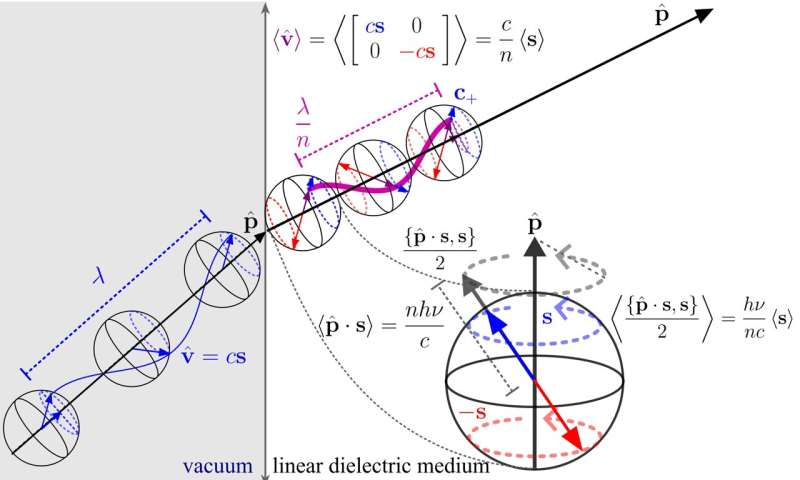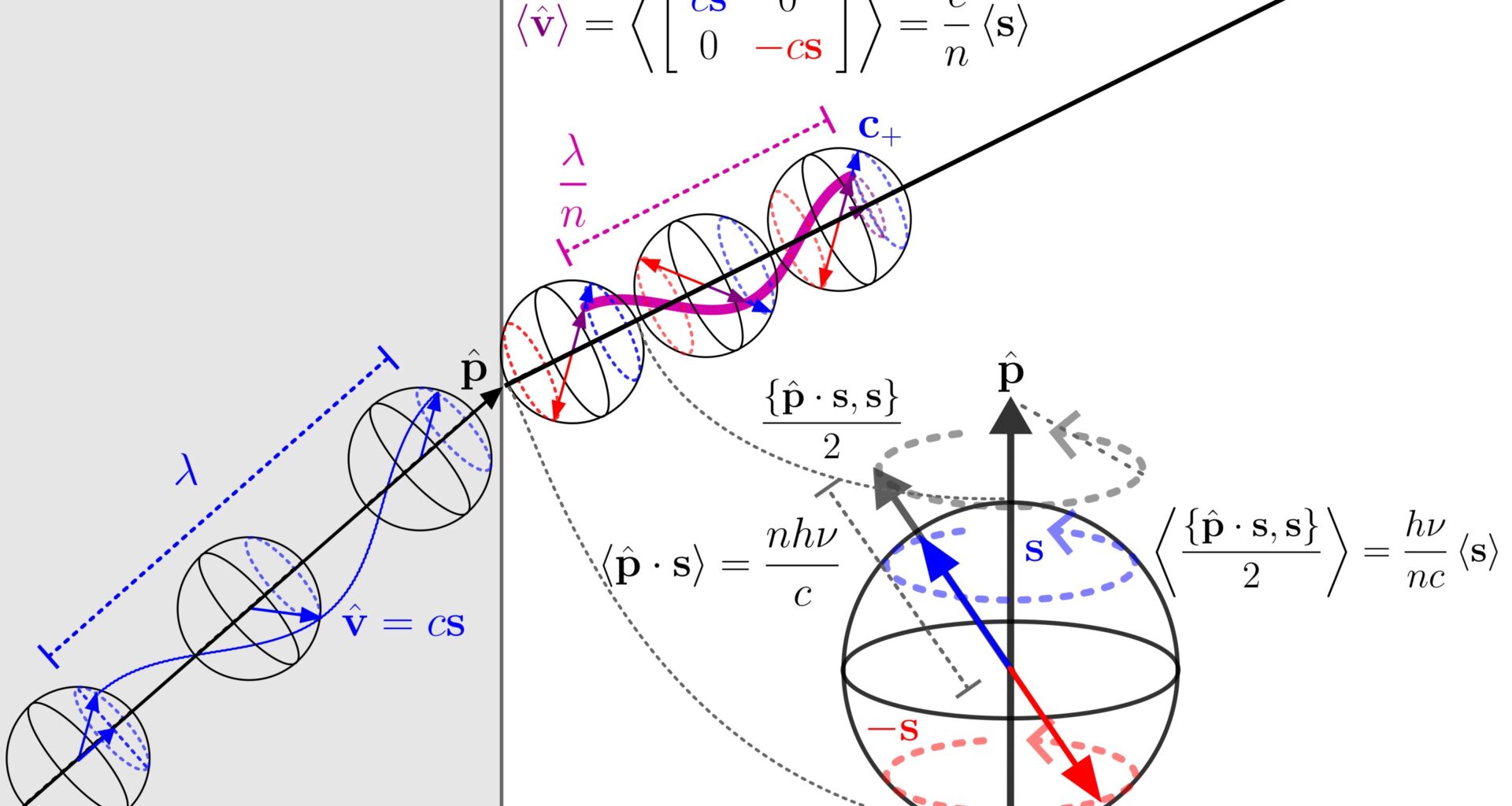by Adam B. Cahaya

When light enters a medium like water or glass, it bends, raising the long-standing question of how much momentum it carries inside. By projecting momentum onto spin, I found a consistent picture: the larger Minkowski momentum corresponds to the magnitude of this spin-projected momentum, while the smaller Abraham momentum is the expectation value of the vector. Credit: Adam B. Cahaya
When you shine a flashlight into a glass of water, the beam bends. That simple observation, familiar since ancient times, hides one of the oldest puzzles in physics: what really happens to the momentum of light when it enters a medium?
In quantum physics, light is not just a wave—it also behaves like a particle, carrying energy and momentum. For more than a century, scientists have debated whether light’s momentum inside matter is larger or smaller than in empty space. The two competing answers are known as the Minkowski momentum, which is larger and seems to explain how light bends, and the Abraham momentum, which is smaller and matches the actual push or pull that light exerts on the medium.
The controversy never went away because experiments seemed to confirm both sides. Some setups measured the larger Minkowski value, others supported Abraham, leaving physicists with a paradox.
Why does this matter?
At first glance, the Abraham–Minkowski debate may seem like a technical squabble. But it cuts to a deep question: How do we define momentum in systems where waves and particles intertwine? The answer shapes not only our understanding of fundamental physics, but also technologies like optical tweezers, laser cooling, and photonic devices that rely on precise control of light–matter interaction.
When I began this project, I set out to revisit this century-old controversy. What I found is that the resolution lies not in choosing between Abraham and Minkowski, but in recognizing that both are correct—once we include spin in the picture. My work is published in the journal Physical Review A.
A missing piece: Spin
Spin is the intrinsic “twist” of light waves, a quantum property as fundamental as energy or momentum. By projecting momentum onto spin, I found a unified description: the Minkowski momentum corresponds to the magnitude of this spin-projected momentum, while the Abraham momentum is its expectation value—the average that actually drives motion and is directly tied to the Lorentz force on the medium.
This reframes the problem: Abraham and Minkowski are not rivals but complementary aspects of the same spin–momentum structure.
From electrons to light
To reach this result, I wrote the equations of motion for light in a medium in a form similar to the famous Dirac equation that describes relativistic quantum particles.
This approach makes spin a good quantum number for light, letting us clearly distinguish the roles of Minkowski and Abraham momentum. It also predicts a trembling motion of light—a zitterbewegung-like oscillation—long associated with Dirac particles like electrons.
Closing thoughts
For me, this journey has been about more than resolving a century-old puzzle. It shows how long-standing questions in physics can sometimes be reframed by looking at them through the lens of a deeper symmetry—in this case, the spin of light itself.
What excites me most is that this framework finally unifies the two perspectives. Instead of Abraham and Minkowski being in conflict, they describe different facets of the same underlying structure. Light bends, pushes, and even trembles. Its spin connects these behaviors, linking the geometry of refraction with the mechanics of momentum transfer.
To me, this reinforces something profound: light, though describable as a wave, carries an unmistakably particle-like character.
This story is part of Science X Dialog, where researchers can report findings from their published research articles. Visit this page for information about Science X Dialog and how to participate.
More information:
Adam B. Cahaya, Zitterbewegung, momentum, and spin dynamics of electromagnetic waves in a linear dielectric medium, Physical Review A (2025). DOI: 10.1103/sxh8-q8tq
Adam B. Cahaya, is an Associate Professor of Physics at Universitas Indonesia. Cahaya’s research focuses on theoretical condensed matter physics, with a particular emphasis on spin dynamics.
Cahaya completed a B.Sc., M.Sc., and Dr.Sc. in Physics at Tohoku University, Japan, investigating spin dynamics and their role in next-generation spintronic devices. Since then, Cahaya’s work has expanded to explore quantum phenomena and spin dynamics in nanoscale condensed matter systems—not only the spin of moving electrons, but also the behavior of magnons and photons.
Citation:
Spin may resolve century-old puzzle of light’s momentum in matter (2025, September 24)
retrieved 27 September 2025
from https://phys.org/news/2025-09-century-puzzle-momentum.html
This document is subject to copyright. Apart from any fair dealing for the purpose of private study or research, no
part may be reproduced without the written permission. The content is provided for information purposes only.
